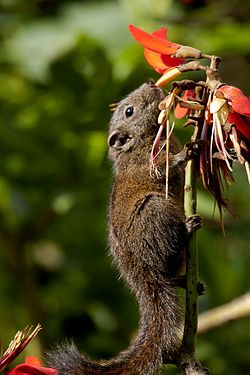| Nilgiri striped squirrel | |
|---|---|
 | |
| Scientific classification | |
| Kingdom: | Animalia |
| Phylum: | Chordata |
| Class: | Mammalia |
| Order: | Rodentia |
| Family: | Sciuridae |
| Genus: | Funambulus |
| Species: | F. sublineatus |
| Binomial name | |
| Funambulus sublineatus (Waterhouse, 1838) | |
| Subspecies [2] | |
See text | |
| Synonyms | |
Sciurus delesserti Gervais, 1841 Contents | |
The Nilgiri striped squirrel (Funambulus sublineatus) is a threatened species of rodent, a small squirrel (Sciuridae) from rainforests in the southern Western Ghats, including the Nilgiris, in Peninsular India. It formerly included Funambulus obscurus from Sri Lanka as a subspecies, at which point the English name of the "combined species" also was dusky striped squirrel (a name now restricted to the Sri Lankan species).
